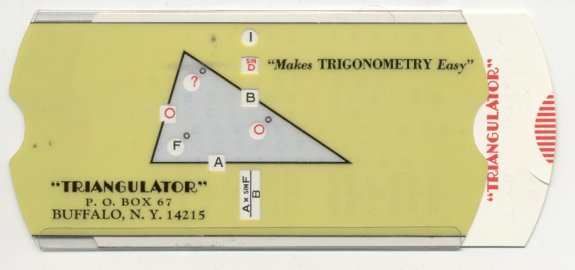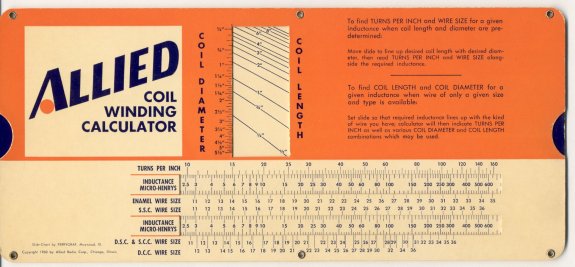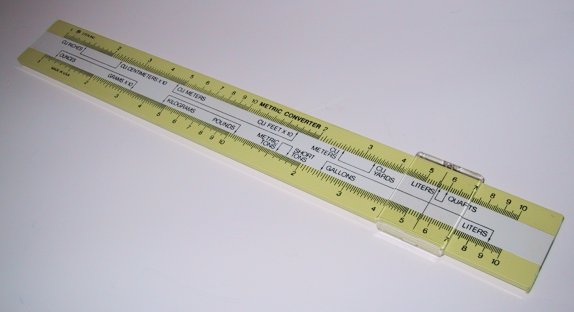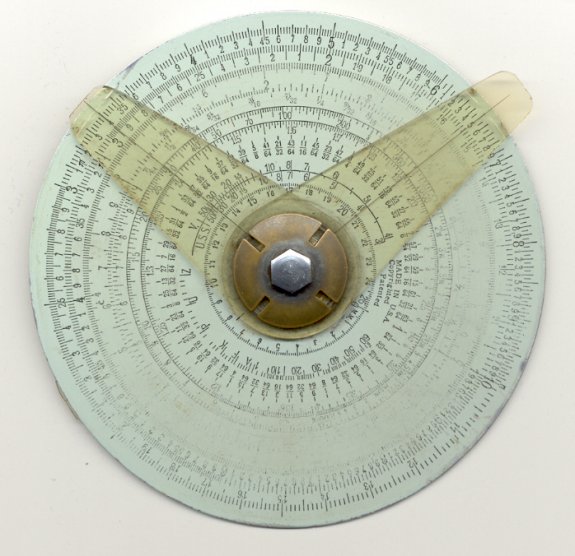
I went in for my upper set work yesterday, and spent eight and a half hours in the chair, from 7 AM to 3:30 PM. It took two solid hours for the surgeon to cut my upper horseshoe out of my mouth, consuming (I asked) twelve burrs in the process, three diamond and eight carbide. The cottage cheese I had for supper last night tasted distinctly of machine shop.
But let all that pass; the less you know the better you'll sleep. What I want to talk about this morning is the fact that slide rules are not dead. By no means; I use them regularly, if not every single day. The catch is that they're not general-purpose mathematical slide rules. They're application-specific slide rules that do one thing only—or perhaps two or three related things.
A good example is something I got from Carol's late father: The Triangulator, shown above. It doesn't do trig calculations, but it sets them up for you, depending on which values for a given triangle are known, and which are unknown. Slip the slide back and forth until the holes show you the unknown (a question mark) and the knowns (printed in black) and it will display the formula you need to run to get the unknown.
I've used the Triangulator a time or two, but the one that I've used the most is shown below: Allied Radio's coil winding calculator. The copyright notice says 1960, and I bought it at a hamfest for a dollar years'n'years ago. You can use it to quickly figure a coil for a radio project, assuming you know the inductance required, and if you don't, the flipside of the calculator calculates resonance and both inductive and capacitive reactance. (Slide rules, like records of old, generally had two sides.)

I have a similar reactance calculator from Shure Brothers, but it doesn't have the coil winding feature. Elsewhere in the collection are a couple of English/Metric conversion items, including one I've discussed here before. My favorite actually looks like a slide rule, and isn't made of cardboard:

I scanned all of what came easily to hand this morning, and if you're interested you can bring down the biggish image files. Image 1. Image 2. Image 3. The most mysterious one in my collection belonged to my father. It's circular, and he clearly used it a lot, because the scales on one side are largely worn away.

I've figured out how to do a few things with it, including fraction/decimal conversions and reciprocals, but whether it's got the ability to do general multiplication/division or even square roots is obscure. (The other side is a straightforward circular trig table.) I discern no equivalent of an A nor a D scale, nor how the two hairlines interact. I think it's this item, but lacking a manual I have no way to be sure, and there's no manufacturer's name on it.
So let it not be said that slide rules are extinct. I'm guessing that somewhere is a manufacturer still producing cardboard species as promo items, as I got a world time calculator at a trade show booth as recently as 1996. I like them, as each one doesn't need its own damned wall wart, and they can show relationships as well as values. Toss 'em in a drawer, and when you need one, well, it still works. “Analog” is a real word!










